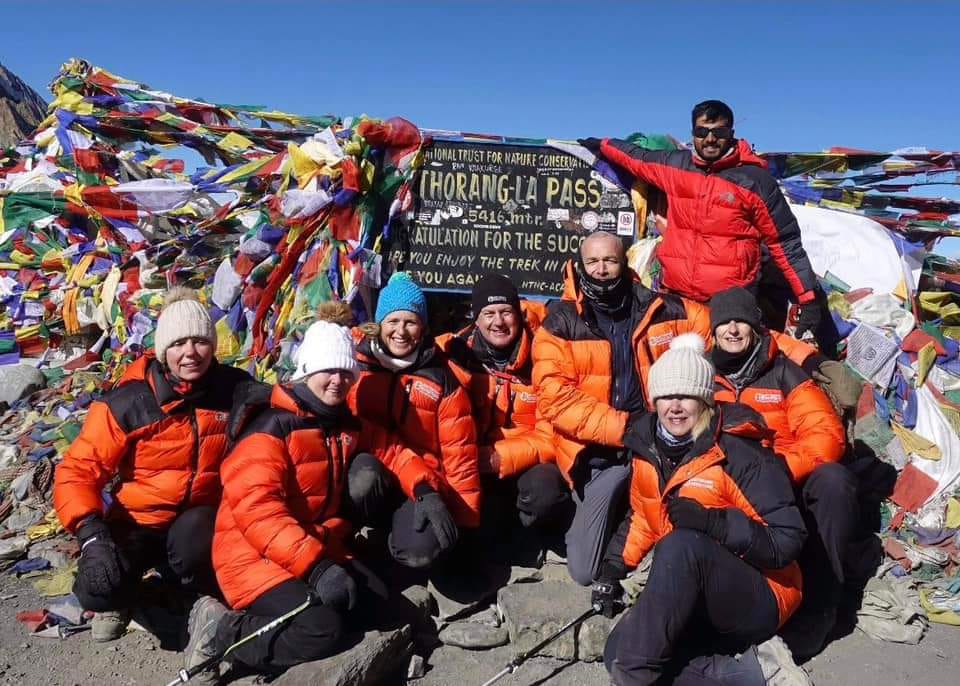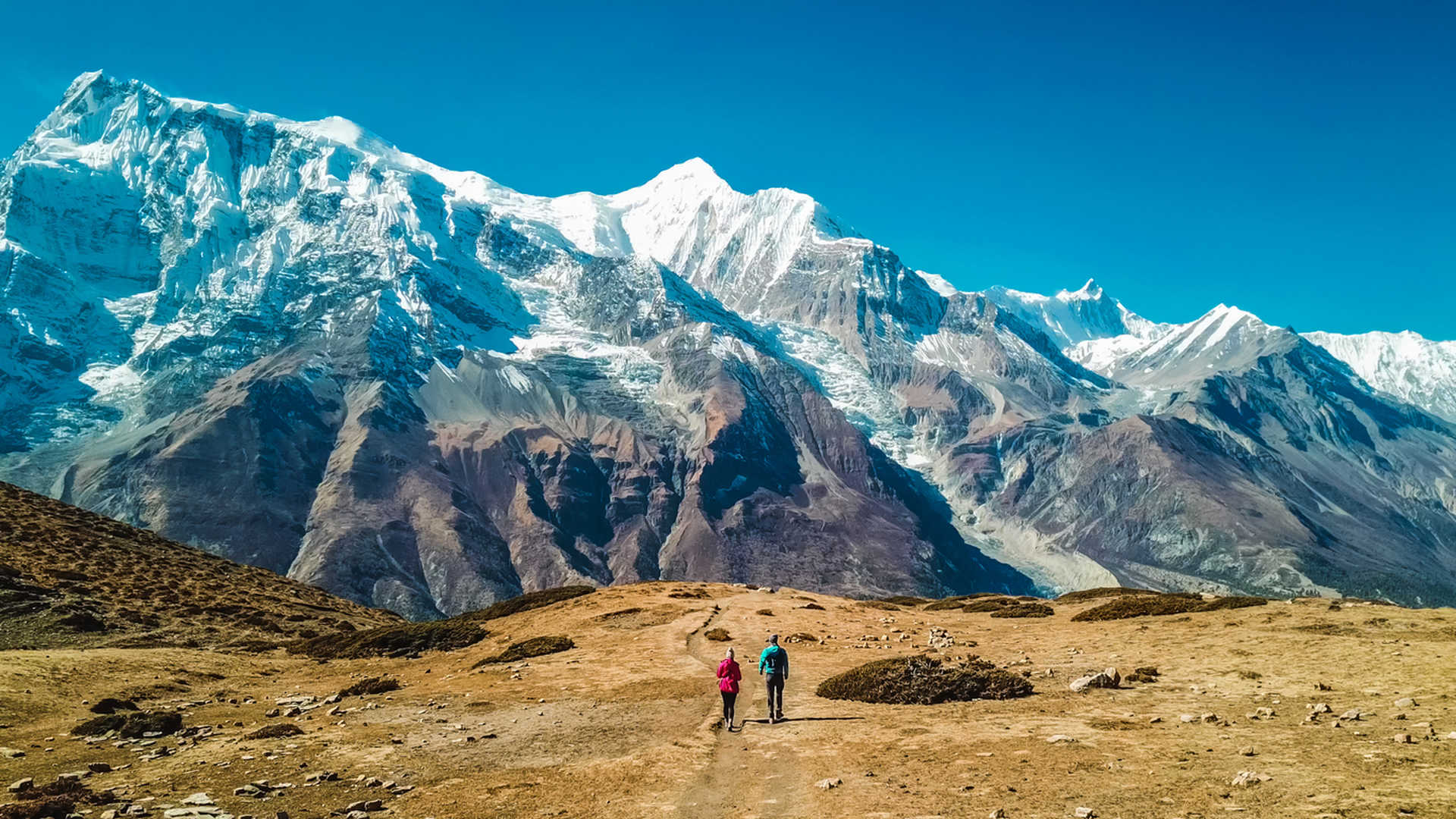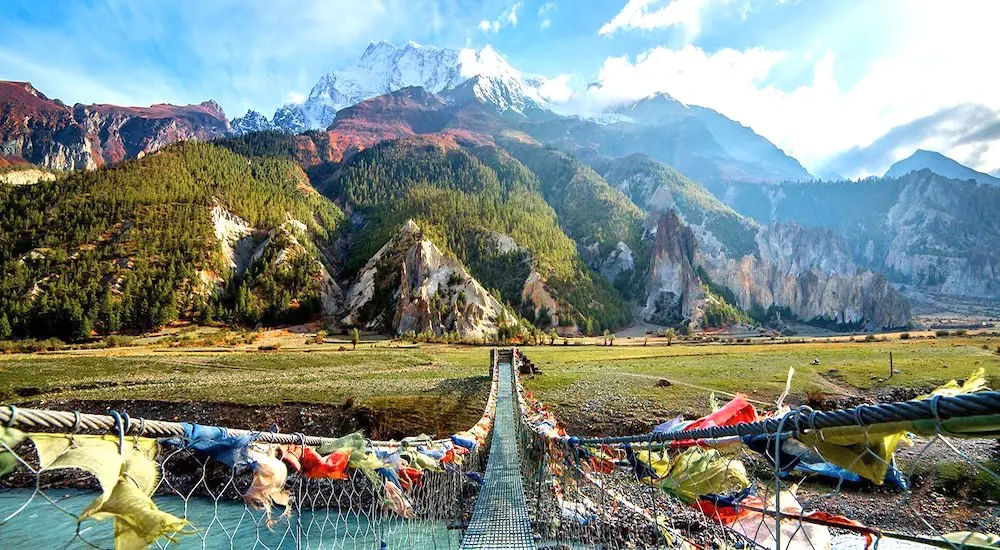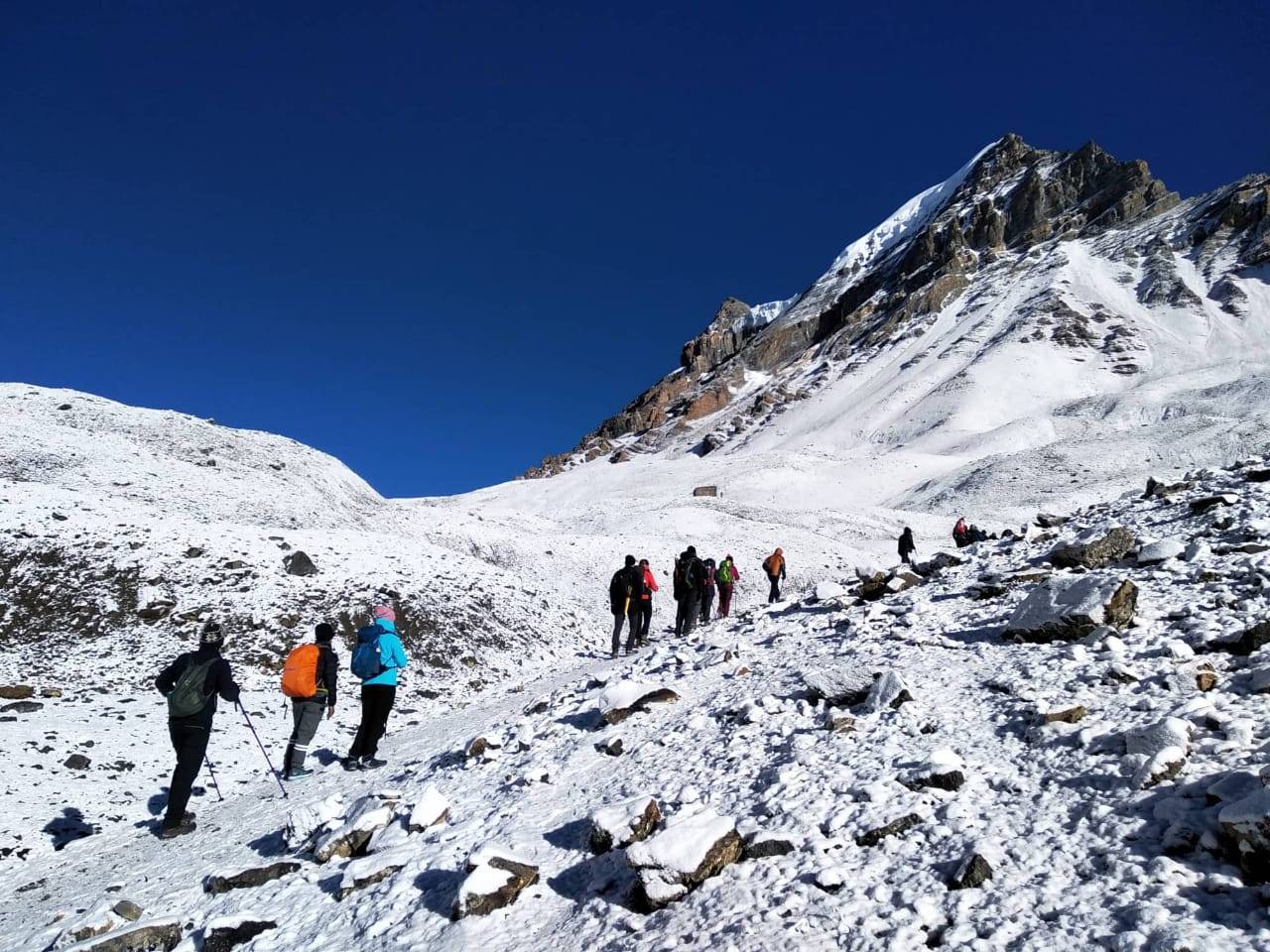Annapurna Circuit Trek is the world’s most popular and fulfilling trekking trail that provides trekkers with the pleasure of an enchanting mingling of virgin nature, cultural heritage, and a sit-on-the-edge-of-your-seat adventure. Being at the core of the Himalayas, the trek is a trek from start to finish, whereby you would be able to observe the emerald valleys, meadows of alpine forest, and snow-white peak mountains, and also undergo the different traditions of the inhabitants. A seasoned trekker and also an amateur trekker taking it through an adventure trail, there is something for all at the Annapurna Circuit.

Description of the Annapurna Circuit Trek
Annapurna Circuit Trek, or simply referred to as the “classic trek,” is approximately 160 to 230 kilometers long, depending on the trek route, and starts at low Annapurna foothills and ascends as high as Thorong La Pass (5,416 meters).
The hike is around 12-21 days in duration and varies from subtropical jungle through to alpine grass and rough dry land on the other side of the pass. The tourists would have the opportunity to view villages, monasteries, and people leading conventional lives of Gurung, Thakali, and Manangi tribes on their way.
A Varied Landscape Trek
Annapurna Circuit Trek is a reward-risk, varied landscape trek. Trek begins in middle of the valley at dark green dense subtropical oak and rhododendron forest. With rising altitude, the terrain has been sculpted into extraterrestrial beauty of alpine grassland, glacial brook, and bare boulders. Gradient from low to high altitude is progressive, and trekkers have luxury of acclimatization.
Lower Annapurna
The trekking route begins from Syange and Besisahar villages. Subtropical forests and wildlife make up this region. The trek presents smiling, warm villagers with tended fields and verdure too. Acclimatization for trekking in the Himalayas is offered by the lower part of the trek with a view of Machapuchare and Annapurna ranges in this range.
Manang Valley
The climbers continue climbing and climbing, and they arrive at Manang Valley. It is encircled by the Annapurna II, III, and IV mountains themselves and hence it is a resting spot as such. The climbers rest here for two days of acclimatization so that they would not be disturbed by mountain sickness. The local stone houses of the region and the Buddhist monasteries show most of the religiosity and culture of the region.

Thorong La Pass
The trekker’s trinity holy, Thorong La Pass itself at 5,416m, is challenging but exhilarating to get to. The view from the top is breathtaking, with he rolling sweep of the immediate Himalayan ridges. Snow-capped Annapurna peaks and the Tibetan Plateau in the distance are the trekker’s Eldorado in pursuit of the pass.
Jomsom & Muktinath
Blowing snow, freezing. Trekking to Jomsom and Muktinath through Thorong La Pass. Shelled by ruthless Tibetan soldiers, Buddhist temples, stupas, prayer flags, and monasteries. Buddhists and Hindus have both consecrated Muktinath as a holy place holy place and one single temple was built in memory of Lord Vishnu. Muktinath’s serene religious scene is a serene peak to the Annapurna Circuit Trek.
Immersive Cultural Experience in the Trek
The natural landscape of the Annapurna Circuit is the most spectacular attraction, yet the experience of culture one gets while trekking there is equally invaluable. Trek leads through a series of villages and hamlets to be passed and meet the inhabitants and experience their life and culture.

Ethnic Diversity:
Annapurna region is ethnically rich with the Gurung, Thakali, and Manangi population. They have a unique language, culture, and way of life. Rural life like Ghandruk with stone houses and wooden ornamental temples that represent Gurung society, but Thakali food is exotic cuisine with fewer reliance on dal bhat and momos.
Hindu and Buddhist influence:
Buddhist prayer flags, stupas, and monasteries are scattered along the Annapurna Circuit, with a powerful presence being experienced in Manang and Muktinath. Apart from providing it with its beauty, there is the radiance of the traditional geographic Hindu and Buddhist cultural gems from one location to another. Then there is the Muktinath Temple at Muktinath, a holy pilgrim temple shared by Buddhists and Hindus, where pilgrims are purified by 108 spouts of water as they undergo a purification ritual.
Local Food:
Local Nepalese food of the region is most accessible by staying within the trek itself. Treks’ teahouses are located within villages where local food is eaten. Dal bhat (lentil soup and rice) is standard fare, then noodle soups, momos (steamed dumplings), and Tibetan bread. Trek food tastes bland but healthy and gives the trekker plenty of vigor for the day’s trek ahead.
Adventure and Thrills: Thorong La Pass Crossing
The crowning glory of the Annapurna Circuit Trek is Thorong La Pass, a pass at high altitude, owing to having notoriously volatile attitude, owing to its legendary climatic conditions. Overcoming the past is an achievement owed to sheer persistence and tenacity.
The Ascent:
The Ascent to Thorong La Pass is a most exhausting, lengthy exercise, either from the High Camp or from the Yak Kharka region. The most dangerous part of trekking people try to complete it in the morning so that they don’t have to run the risk of being blown up by gusts in the afternoons, and also have enough time to return.
The Descent:
Downhill descent to Muktinath is achieved after trekkers have reached the top once and for all, and steep and rocky in some places slopes slope downwards. Steep descent becomes possible from higher altitudes, and relief of trekkers is felt mainly after lower altitudes are reached.
Acclimatization and Altitude:
Acclimatization is essential to avoid altitude sickness. Trekkers must allow for additional days of acclimatization at a higher altitude before ascending to Thorong La. Ascent based on altitude and rest days will make the trek safer and more enjoyable.
Optimum Trekking Time to Annapurna Circuit
The trek to Annapurna Circuit can be accomplished throughout the year, though the best time for arranging this trek is either during the spring season from March to May or the fall from September to November. They are the times for guaranteed weather, blue sky, and an excellent view of the mountains. Rhododendron forests laden with pink-blossomed flowers make a bonus trip feature in the spring. In fall, one is offered fair weather, with a nice cool climate perfect for the trek.
Total Cost Breakdown
1. Permits
You will also have to carry two significant permits with you while you walk along the Annapurna Circuit: the Annapurna Conservation Area Permit (ACAP) and the Trekkers’ Information Management System (TIMS) card. The ACAP will cost approximately NPR 3,000 (or USD 25) and goes towards the conservation of the Annapurna area. The TIMS card, which is compulsory for every trekker, costs approximately NPR 1,000 (USD 8) and is utilize for the trekkers’ records in the area for administrative and safety purposes. The cards can be bought at Pokhara or Kathmandu and are compulsory for any trek in the Annapurna area. The cards cost approximately NPR 4,000 (USD 33), a minor but unavoidable cost of the trek.
2. Transport
It is a good idea to also arrange transport from and to the Annapurna area. Your trek starts in Kathmandu, and you travel to Pokhara by tourist bus. Bus prices are NPR 1,000–1,500 (USD 8–12) depending on the agency and class. From Pokhara, you travel by bus or jeep to Besisah, where your trek starts. The price will be NPR 200–300 (USD 2–3). For extra comfort or in case of limited time, private transport services, i.e., jeep, can be rent at NPR 5,000–10,000 (USD 40–80) per day. Part of air travel from Pokhara to Jomsom is also utilize for trekking and can be rented for one way at NPR 4,000–6,000 (USD 35–50). Transport cost on average will vary by mode of transport from NPR 5,000 to 15,000 (USD 40–120).
3. Accommodation
The accommodation along the Annapurna Circuit is typically in tea houses or guesthouses. On the lower-altitude parts like Besisahar and Syange, the guesthouse accommodation will be between NPR 300 to 700 (USD 3–6) per night. The higher one climbs to places like Manang and Thorong Phedi, the price rises to NPR 500 to 1,000 (USD 4–9) per night because of fewer facilities. Tea houses are very basic in terms of accommodation, i.e., a bed, boarding, and food, but more expensive at high altitudes as logistics are complicate. Accommodation for a 14–21-day trek usually costs NPR 5,000–15,000 (USD 40–120), depending on how many days you trek and what standard of accommodation you use.

4. Food
Food is provide by the tea houses during the Annapurna Circuit, which is include in the trekking package. The most common foods are breakfast, lunch, and dinner in the price of total trekkers’ cost. The breakfast is usually NPR 300 to NPR 500 (USD 3–4) and includes foods like porridge, eggs, and bread. Lunch and dinner are also affordable at NPR 400 to NPR 800 (USD 4–7) per session. Where the altitude is higher, i.e., Manang and Thorong Phedi, there is less added cost since locals are distant and there is more operating cost on tea houses. You would be charge NPR 10,000–20,000 (USD 85–170) for food for a 14 to 21-day trek, depending on what one eats for lunch and dinner, and how many snacks and drinks are consume.
5. Guide and Porter (Optional but Highly Recommended)
One can hike solo without a guide and a porter, but one should hire one since there are several benefits, including navigating along the trail, carrying heavy backpacks, and receiving geographical and cultural insights. Guide fee would be NPR 2,500–4,500 (USD 20–40) daily, and porter fee would be NPR 2,000–3,500 (USD 17–30) daily. To have a guide and porter is convenient during trekking without weariness and, secondly, for safety, particularly during remote trekking or high-altitude treks. Guide and porter can cost between NPR 63,000-120,000 (USD 540-1,020) for a 1a 4 21-day trek, depending on the duration of trekking and the services included.
6. Equipment and Gear
You will need the right equipment to undertake the Annapurna Circuit, i.e., the right trekking shoes, good clothes, a good sleeping bag, a daypack, etc. New equipment can be bought for NPR 5,000 to NPR 15,000 (USD 40–130) based on quality and brand. Or one could opt for rentals if buying equipment is not an option. Day hire of trekking gear such as jackets and sleeping bags is NPR 200 to NPR 500 (USD 2–5) per day. Equipment purchase or hire varies from NPR 5,000 to NPR 20,000 (USD 40–170) depending on preference and duration of the trek.
7. Miscellaneous Expenses
You will have to spend some extra miscellaneous expenses on hot showers, gadget recharging, and internet. Hot showers and bath facilities will be provided in tea houses for NPR 100 to 500 (USD 1–4), mostly at higher elevations. Mobile phone, camera, or equipment charging is usually provided for NPR 100 to 500 per hour (USD 1–4). Internet facility is also provided in some tea houses for NPR 200 to 500 per hour (USD 2–5). Tea and coffee are also available on the trek at NPR 100 to NPR 400 (USD 1–4) per unit. The rest adds up, and the trekkers would pay NPR 5,000 to NPR 10,000 (USD 40–85) for the trekking services.
8. Contingencies and Miscellaneous Expense
Disasters do not occur, but the unthinkable also has to be consider. Emergency helicopter evacuation, in case of need, would be NPR 30,000 to NPR 100,000 (USD 250–850) depending on gravity and location. Additionally, insurance of NPR 5,000 to NPR 10,000 (USD 40–85) in a bundled package covering normal insurance for medical, evacuation, and delayed baggage is recommend.

What to Expect: Tips from the Trekkers
Physical Condition
Whether the majority of the trekkers are physically fit enough to complete the Annapurna Circuit Trek or not, it will always be in one’s best interest to stay fit. Keeping fitness at a peak level by doing day-to-day exercises like cardio and strength exercises will get you accustom to physical stress.
Permits
Trekkers will need an Annapurna Conservation Area Permit (ACAP) and a Trekker’s Information Management System (TIMS) card to trek there. Permits are easily available in Pokhara or Kathmandu.
Gear
Proper trekking gear ensures the trek is comfortable and safe. Warm dressing (and in summer too), good treks, reasonable sleeping bags, and a daypack are require. Don’t miss additional clothing for climatic changes from the lowland heat to the high Himalaya cold.
Porters and Guides
You don’t necessarily have to trek the Annapurna Circuit with a guide or a porter, but it would be more fulfilling if you have one. Guides can provide some useful information on the geology and culture of the region, and porters can carry your large pack so that you’ll trek more easily.
Conclusion
Embark on the Annapurna Circuit Trek for an adventure that will challenge, inspire, and leave you with memories that last a lifetime. Annapurna — peaks that have drawn generations of explorers and mountaineers but it’s more than that. Nepal’s less touristy vacation spots are not choices they are, in the best possible way, true Nepal.
If you do it differently, you’re spending the tourist dollar, you’re supporting the local culture and you have a better holiday. Contact us today at Happy Mountain Nepal, on Facebook, Instagram, or TikTok
FAQs
1. How long does it take to do the Annapurna Circuit Trek?
The trek would last around 12 to 21 days depending on the route, pace, and acclimatization days. Others cut short by jeep or by half flying the trail.
2. When is the Annapurna Circuit highest?
The highest is Thorong La Pass, 5,416 meters (17,769 ft). It is among the highest trekking passes on the planet and one of the high points of the trek.
3. Do I need a permit to complete the Annapurna Circuit Trek?
Yes, two permits are need:
Annapurna Conservation Area Permit (ACAP) – NPR 3,000
Trekkers’ Information Management System (TIMS) Card – NPR 1,000
Both can be purchase in Kathmandu or Pokhara.
4. When to undertake the Annapurna Circuit Trek?
Best seasons:
Spring (March to May) – Pleasant weather, rhododendron flowers.
Autumn (September to November) – Stable weather, best scenery.
5. Is the trek difficult?
Moderate to difficult, mainly due to altitude. Proper acclimatization, physical fitness, and preparation are require for a safe and successful trek.
6. Can beginner trekkers undertake the Annapurna Circuit Trek?
Yes, even foreigners are allow to do the trek if they are fit, have enough acclimatization days. Even engage the services of a guide or porter to join them.
7. What kind of facilities?
Facilities are in guesthouses or teahouses with twin beds and simple rooms, and shared toilets. The more primitive the facilities are, the nearer you are to a higher altitude.
8. What kind of food do you serve on the trek?
You’ll find Nepali, Tibetan, and straight Western cuisine, with dal bhat, noodle soup, momos, and Tibetan bread the norm. Food is simple but energy-rich and vegetarian-centered.
9. Can I trek on my own?
Independent trekking is permit, but strongly suggested that you contract the services of a trained guide and/or porter for safety reasons, particularly at high altitudes and in secluded areas.
10. What do I take along on the trek?
The fundamentals are:
Hiking boots, insulated coats, windbreakers that won’t let rain in
Backpack, sleeping bag, water purification tablets
First aid kit, energy bars, headlamp, and sunscreen
Good light, weather-resistant packing for all conditions is the key.
